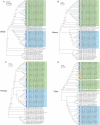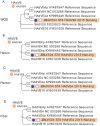Genotypes and Phylogenetic Analysis of Human Adenovirus in Hospitalized Pneumonia and Influenza-Like Illness Patients in Jiangsu Province, China (2013-2021)
- PMID: 38835492
- PMCID: PMC11149707
- DOI: 10.2147/IDR.S456961
Genotypes and Phylogenetic Analysis of Human Adenovirus in Hospitalized Pneumonia and Influenza-Like Illness Patients in Jiangsu Province, China (2013-2021)
Abstract
Background: Human adenovirus (HAdV) is common pathogens that cause various respiratory diseases. The genetic diversity of viruses caused by recombination is considered to be the main source of emerging outbreaks. The aim of this study is to explore the evolutionary relationship and recombination events of HAdV genome in respiratory tract infections in Jiangsu Province.
Methods: Whole-genome sequencing (WGS) technology was used to sequence 66 patients with HAdV infection (37 patients with influenza-like illness (ILI) and 29 hospitalized patients with pneumonia) from Jiangsu Province. Epidemiological analysis was performed on hospitalized pneumonia and ILI patients infected with HAdV. Subsequently, phylogenetic, recombination, and nucleotide and amino acid identity analyses were performed.
Results: Epidemiological analysis of patients undergoing WGS showed that 75.7% of ILI patients were infected with the HAdVB strain and 69.0% of hospitalized pneumonia patients were infected with the HAdVC strain. Moreover, the hospitalized pneumonia and ILI patients infected with HAdV were different in region and time. The strains of HAdVB3 and HAdVB7 genotypes were mainly infected in 2015 and 2017, and the strains of HAdVC1 and HAdVC2 genotypes were mainly infected in 2020. The results of histogram analysis showed that the HAdV strain mainly infected children under 5 years old. In addition, 36 novel recombinant strains were identified. The discovery of these recombinant strains may contribute to understanding the epidemiology of HAdV and research on related vaccines. Furthermore, the percentage of nucleotide and amino acid identities revealed a high level of genetic conservation within isolates from HAdVB3, HAdVB7, HAdVC1, HAdVC2 and HAdVC5 genotypes.
Conclusion: The WGS analysis reveals the evolutionary relationships and recombination events of HAdV strains in Jiangsu Province, which is helpful to deepen the understanding of HAdV epidemiology and evolution. In addition, it provides a basis for the formulation of public health strategies in Jiangsu Province.
Keywords: human adenovirus; phylogenetic analysis; recombination; whole genome sequencing.
© 2024 Wang et al.
Conflict of interest statement
The authors declare that they have no competing interests.
Figures





Similar articles
-
Molecular characteristics of human adenovirus isolated from the 2024 influenza-like illness outbreaks in Suzhou City, China.Virol J. 2025 Jul 15;22(1):243. doi: 10.1186/s12985-025-02870-z. Virol J. 2025. PMID: 40665385 Free PMC article.
-
Whole genomic analysis of a potential recombinant human adenovirus type 1 in Qinghai plateau, China.Virol J. 2020 Jul 22;17(1):111. doi: 10.1186/s12985-020-01387-x. Virol J. 2020. PMID: 32698808 Free PMC article.
-
An outbreak of acute respiratory infection at a training base in Beijing, China due to human adenovirus type B55.BMC Infect Dis. 2020 Jul 23;20(1):537. doi: 10.1186/s12879-020-05258-2. BMC Infect Dis. 2020. PMID: 32703176 Free PMC article.
-
Molecular Identification and Epidemiological Features of Human Adenoviruses Associated with Acute Respiratory Infections in Hospitalized Children in Southern China, 2012-2013.PLoS One. 2016 May 12;11(5):e0155412. doi: 10.1371/journal.pone.0155412. eCollection 2016. PLoS One. 2016. PMID: 27171486 Free PMC article.
-
Molecular typing and epidemiology profiles of human adenovirus infection among hospitalized patients with severe acute respiratory infection in Huzhou, China.PLoS One. 2022 Apr 21;17(4):e0265987. doi: 10.1371/journal.pone.0265987. eCollection 2022. PLoS One. 2022. PMID: 35446868 Free PMC article.
Cited by
-
Current Trends of Human Adenovirus Types Among Hospitalized Children-A Systematic Review.Viruses. 2025 Jun 27;17(7):914. doi: 10.3390/v17070914. Viruses. 2025. PMID: 40733532 Free PMC article. Review.
-
Retrospective study on the epidemiological characteristics of multi-pathogen infections of hospitalized severe acute respiratory tract infection and influenza-like illness in Xinjiang from January to May 2024.BMC Infect Dis. 2025 Feb 23;25(1):252. doi: 10.1186/s12879-025-10654-7. BMC Infect Dis. 2025. PMID: 39988694 Free PMC article.
-
Epidemiological characteristics and genomic analysis of respiratory adenovirus in Jining City from February 2023 to July 2024.BMC Genomics. 2025 Apr 14;26(1):369. doi: 10.1186/s12864-025-11558-1. BMC Genomics. 2025. PMID: 40229673 Free PMC article.
-
Molecular characteristics of human adenovirus isolated from the 2024 influenza-like illness outbreaks in Suzhou City, China.Virol J. 2025 Jul 15;22(1):243. doi: 10.1186/s12985-025-02870-z. Virol J. 2025. PMID: 40665385 Free PMC article.
References
-
- Mennechet FJD, Paris O, Ouoba AR, et al. A review of 65 years of human adenovirus seroprevalence. Jun. 2019;18(6):597–613. - PubMed
LinkOut - more resources
Full Text Sources

